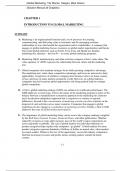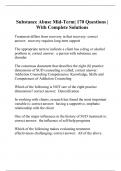(Global Marketing, 10e Warren Keegan, Mark Green)
(Solution Manual all Chapters)
CHAPTER 1
INTRODUCTION TO GLOBAL MARKETING
SUMMARY
A. Marketing is an organizational function and a set of processes for creating,
communicating, and delivering value to customers and for managing customer
relationships in ways that benefit the organization and its stakeholders. A company that
engages in global marketing focuses resources on global market opportunities and threats.
Successful global marketers such as Nestlé, Coca-Cola, and Honda use familiar
marketing mix elements – the four Ps – to create global marketing programs.
B. Marketing, R&D, manufacturing, and other activities compose a firm’s value chain. The
value equation (V =B/P) expresses the relationship between values and the marketing
mix.
C. Global companies also maintain strategic focus while pursuing competitive advantage.
The marketing mix, value chain, competitive advantage, and focus are universal in their
applicability, irrespective of whether a company does business only in its home country
or has a presence in many markets around the world. However, in a global industry,
companies that fail to pursue global opportunities risk being pushed aside by stronger
global competitors.
D. A firm’s global marketing strategy (GMS) can enhance its worldwide performance. The
GMS addresses several issues. First is the nature of the marketing program in terms of the
balance between a standardization (extension) approach to the marketing mix elements
and a localization (adaptation) approach that is responsive to country or regional
differences. Second is the concentration of marketing activities in a few countries or the
dispersal of such activities across many countries. Companies that engage in global
marketing can also engage in coordination of marketing activities. Finally, a firm’s GMS
addresses the issue of global market participation.
E. The importance of global marketing today can be seen in the company rankings compiled
by the Wall Street Journal, Fortune, Financial Times, and other publications. Whether
ranked by revenues or some other measure, most of the world’s major corporations are
active regionally or globally. The size of global markets for individual industries or
product categories helps explain why companies “go global”. Global markets for some
product categories represent hundreds of billions of dollars in annual sales; other markets
are much smaller. Whatever the size of the opportunity, successful industry competitors
find that increasing revenues and profits means seeking markets outside the home
country.
1-1
Copyright © 2020 Pearson Education, Inc.
, F. Company management can be classified in terms of its orientation toward the world:
ethnocentric, polycentric, regiocentric, or geocentric. These terms reflect progressive
levels of development or evolution. An ethnocentric orientation characterizes domestic
and international companies; international companies pursue marketing opportunities
outside the home market by extending various elements of the marketing mix. A
polycentric worldview predominates at a multinational company, whose country
managers operate autonomously, adapt the marketing mix. When management moves to
integrate and coordinate activities on a regional basis, the decision reflects a regiocentric
orientation. Managers at global and transnational companies are geocentric in their
orientation and pursue both extension and adaptation strategies in global markets.
G. The dynamic interplay of several driving and restraining forces shapes the importance of
global marketing. Driving forces include market needs and wants, technology,
transportation and communication improvements, product costs, quality, world economic
trends, recognition of opportunities to develop leverage by operating globally, and
innovation and entreprenuershp. Restraining forces include market differences,
management myopia, organizational culture, and national controls such as nontariff
barriers (NTBs).
OUTLINE OF THE BOOK
The book is divided into five parts.
Part 1: An overview of global marketing and the basic theory of global marketing.
Part 2: The environment of global marketing.
Part 3: Approaching global markets (global strategy)
Part 4: The global context of marketing mix decisions
Part 5: Issues of corporate strategy and leadership in the 21st century.
LEARNING OBJECTIVES
1-1 Use the product/market growth matrix to explain the various ways a company can expand
globally.
1-2 Describe how companies in global industries pursue competitive advantage.
1-3 Compare and contrast a single-country marketing strategy with a global marketing strategy
(GMS).
1-4 Identify the companies at the top of the Global 500 rankings.
1-2
Copyright © 2020 Pearson Education, Inc.
,1-5 Explain the stages a company goes through as its management orientation evolves from
domestic and ethnocentric to global and geocentric.
1-6 Discuss the driving and restraining forces affecting global integration today.
DISCUSSION QUESTIONS
1-1. What are the basic goals of marketing? Are these goals relevant to global marketing?
Marketing activities represent an organization’s efforts to satisfy customer wants and
needs by offering products and services that create value. These goals are relevant in
virtually every part of the world; however, when an organization pursues market
opportunities outside of its home country (domestic) market, managers need an
understanding of additional conceptual tools and guidelines in order to do business in
these other countries – in other words, to create value and satisfy consumer needs and
wants.
1-2. What is meant by “global localization?” Is Coca-Cola a global product? Explain.
The phrase “global localization” represents an attempt to capture the spirit of the rallying
cry for organizations in the 21st century, namely, “think globally, act locally, and manage
regionally.” Most students will agree that Coca-Cola is a global product by virtue of the
fact that it is available in more than 195 countries in red cans bearing the distinctive
signature style. It must be noted, however, that customer service efforts are adapted to the
needs of particular markets (for example, vending machines in Japan). Thus, Coca-Cola
is both global and local.
1-3. A company’s global marketing strategy (GMS) is a crucial, competitive tool. Discuss some
of the global marketing strategies available to companies. Give examples of companies that use
the different strategies.
Strategies include global branding (Coca-Cola, Apple), product design (McDonald’s
restaurants and menu items), positioning (Harley-Davidson), packaging (Gillette Sensor),
distribution (Benetton), customer service (Caterpillar), and sourcing (Toyota, Gap).
1-4. UK-based Burberry is a luxury fashion brand that appeals to both genders and all ages. To
improve Burberry’s competitiveness in the luxury goods market, CEO Marco Gobetti must
update the marketing program put in place by his predecessor. The strategy should address key
markets that Burberry will participate in, as well as the integration and coordination of marketing
activities. Research recent articles about Burberry and write a brief summary that outlines
Burberry’s GMS.
1-3
Copyright © 2020 Pearson Education, Inc.
, Student answers will vary, but all should contain the new challenges to the company’s
GMS including the declining popularity of department stores in the US and the slowing
sales of luxury goods in China.
1-5. Discuss the differences between the global marketing strategies of Harley-Davidson and
Toyota?
Harley-Davidson motorcycles are known the world over as “the” all-American
motorcycle. Harley’s mystique and heritage are associated with America. The company
backs up this positioning with exports from two U.S. manufacturing locations. By
contrast, Toyota builds some models (e.g. Camry) for the U.S. market in the U.S., a fact
that Toyota stresses in its American advertising. Thus, Harley-Davidson serves global
markets while sourcing locally, while Toyota’s strategy calls for serving world markets
and using the world as a source of supply.
1-6. Describe the differences between ethnocentric, polycentric, regiocentric, and geocentric
management orientations.
The premise of an ethnocentric orientation is that home country products and
management processes are superior. An ethnocentric company that neither sources inputs
from, nor seeks market opportunities in the world outside the home country may be
classified as an international company. A company that does business abroad while still
presuming the superiority of the home country may be classified as an international
company. Such a company would rely on an extension strategy whereby it would export,
without adaptation, products designed for the domestic market.
The polycentric orientation that predominates at a multinational company leads to a view
of the world in which each country market is different from the others. Local country
managers operating with a high degree of autonomy adapt the marketing mix in a
polycentric, multinational company. Managers who are regiocentric or geocentric in their
orientations recognize both similarities and differences in world markets. Market
opportunities are pursued using both extension and adaptation strategies. The regiocentric
and geocentric orientations are characteristic of global transnational companies.
1-7. Identify and briefly describe some of the forces that have resulted in increased global
integration and the growing importance of global marketing.
The dynamic involving driving and restraining forces is shown diagrammatically in
Figure 1-1. Driving forces include regional economic agreements such as NAFTA,
converging market needs and wants, technology advances such as the Internet and global
TV networks, transportation improvements, the need to recoup high product development
costs in global markets, the need to improve quality through R&D investment, world
economic trends such as privatization and finally, opportunities to use leverage, corporate
culture, and the continuing presence of national controls that create trade barriers.
1-4
Copyright © 2020 Pearson Education, Inc.





